|

Introduction
There's been a real push from manufacturers
recently on releasing new gaming monitors, mostly thanks to the arrival of
adaptive refresh rate technologies from AMD and NVIDIA. The new FreeSync and
G-sync technologies have been incorporated into many new displays and we've
already reviewed a few excellent options from Asus, Acer and BenQ. Perhaps of
most interest recently was the
XB270HU from Acer, the World's first 144Hz IPS-type display, with added
G-sync support and a blur reduction mode (ULMB). Whilst that model is an NVIDIA
G-sync capable display, Acer have now released the very similarly named XG270HU
which is a screen supporting AMD's FreeSync instead. Unlike the XB model this is
a TN Film screen, sporting a 1ms G2G response time and 144Hz refresh rate.
It has a rather different and distinctive design as well so probably won't be
easily confused. This will be the second FreeSync screen we've tested, after the
recent
BenQ XL2730Z.
Acer's website states:
"Acer XG monitors deliver powerful visuals on a frameless screen to free your
gaming and movie experiences from visual borders. WQHD resolution combines with
high refresh rates and short response times for ultra-smooth action. These
monitors also support FreeSync technology, for tear-free and stutter-free
gaming. Plus, built-in eye protection and ergonomics keep things comfortable."
If you appreciate the review
and enjoy reading and like our work, we would welcome a
donation
to the site to help us continue to make quality and detailed reviews for you.
|
Check Pricing and Buy - Direct Links
|
|
Amazon USA |
Amazon UK |
Amazon GER |
Amazon CAN
|
|
TFTCentral is a participant
in the Amazon Services LLC Associates Programme, an affiliate
advertising programme designed to provide a means for sites to earn
advertising fees by advertising and linking to Amazon.com, Amazon.co.uk,
Amazon.de, Amazon.ca and other Amazon stores worldwide. We also
participate in a similar scheme for Overclockers.co.uk. |

Specifications and Features
The following table gives detailed information
about the specs of the screen:
|
Monitor
Specifications |
|
Size |
27"WS (69 cm) |
Panel Coating |
Medium AG coating |
|
Aspect Ratio |
16:9 |
Interfaces |
DisplayPort, DL-DVI,
HDMI 2.0
|
|
Resolution |
2560 x 1440 |
|
Pixel Pitch |
0.233 mm |
Design
colour |
Black and bronze/orange |
|
Response Time |
1ms G2G |
Ergonomics |
Tilt only |
|
Static Contrast Ratio |
1000:1 |
|
Dynamic Contrast Ratio |
100 million:1 |
VESA Compatible |
No |
|
Brightness |
350 cd/m2 |
Accessories |
Power brick, DisplayPort, DVI and audio cables |
|
Viewing Angles |
170 / 160 |
|
Panel Technology |
AU Optronics TN Film |
Weight |
net: 3.86 Kg |
|
Backlight Technology |
W-LED |
Physical Dimensions |
(WxHxD)
614 x 451 x 206mm |
|
Colour Depth |
16.7m |
|
Refresh Rate |
40 - 144Hz
FreeSync support |
Special
Features |
FreeSync, audio in, headphone out, 2x 2W integrated speakers |
|
Colour Gamut |
Standard gamut
~sRGB, ~72% NTSC |
The XG270HU offers a decent range of connectivity
options with DisplayPort, HDMI 2.0 and DL-DVI provided. The screen is not
limited to DisplayPort-only like G-sync screens are (a limitation of the current
G-sync module from NVIDIA), as FreeSync allows for other connections to still be
offered on the screen, even though the DisplayPort is the only one to support
the actual FreeSync technology. That is certainly a pro for FreeSync over G-sync
The digital interfaces are HDCP certified for encrypted content and the video
cables are provided in the box for DisplayPort and DVI, along with an audio
cable (in the UK at least).
The screen has an external power supply which
comes provided. There are no USB ports provided on this model unfortunately and
it is a little limited in terms of extras. There are audio in and headphone out
connections, as well as integrated 2x 2W speakers.
Below is a summary of the features and connections
of the screen:
|
Feature |
Yes / No |
Feature |
Yes / No |
|
Tilt adjust |
 |
DVI |
 |
|
Height adjust |
 |
HDMI |
 |
|
Swivel adjust |
 |
D-sub |
 |
|
Rotate adjust |
 |
DisplayPort |
 |
|
VESA compliant |
 |
Component |
 |
|
USB 2.0 Ports |
 |
Composite |
 |
|
USB 3.0 Ports |
 |
Audio connection |
 |
|
Card Reader |
 |
HDCP Support |
 |
|
Ambient Light Sensor |
 |
MHL Support |
 |
|
Human Motion Sensor |
 |
Integrated Speakers |
 |
|
Touch Screen |
 |
PiP / PbP |
 |
|
Factory Calibration |
 |
Blur Reduction Mode |
 |
|
Hardware calibration |
 |
G-Sync |
 |
|
Uniformity correction |
 |
FreeSync |
 |

Design and Ergonomics


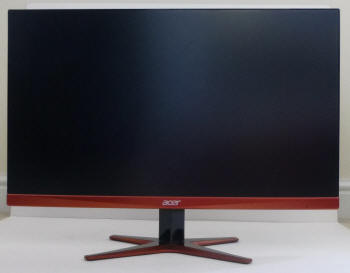
Above: front views of the screen.
Click for larger versions
The XG270HU comes in a black and
orange/bronze design with a mixture of matte and glossy plastics used. The
screen has a borderless design and so has a very thin outer bezel along the top
and sides which is only ~2mm thick. There is then an additional ~6.5m of
inner panel border before the image starts so the actual edges are ~8.5mm thick in total. Along the
bottom edge of the screen is a thicker orange/bronze coloured
plastic trim measuring ~23mm thickness. There is a matte silver 'acer'
logo in the middle of the bottom bezel and a small power LED and logo in
the bottom right hand area, but no other markings or writing on the screen
at all.

Above: rear
view of the screen
The back of the screen is finished in a
glossy black plastic as shown above. The interface connections are near
the bottom as shown above, and there's a large Acer logo in the upper left
hand corner (as viewed from the back). There is no cable tidy provided
unfortunately although the screen sits quite low down so it's hard to see
anything behind the monitor from a normal viewing position. There are no
VESA mounting holes on this model so you cannot wall or arm mount the
screen sadly.

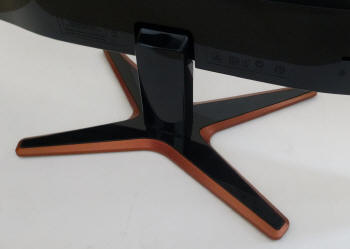
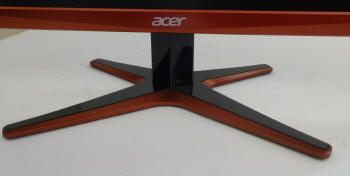
Above:
further rear views including the stand. Click for larger versions
The stand attaches at the bottom of the back
of the screen as you can see above, with the base being packaged
separately but easily screwed on to the arm. The base is again glossy
black plastic with orange/bronze coloured trim around the edges. It
provides a wide base for the screen but because of the small supporting
arm and the fact it attaches to the bottom of the screen, the monitor is
very wobbly if touched or moved. Day to day it remains stable on the desk
while typing and working, but if you want to move it around or use the OSD menu
then it does wobble a lot.
 
Above:
side views of the screen
From a side view the screen has a nice thin
profile thanks to its W-LED backlighting and external power brick. It
would have been a nice option for wall-mounting had there been VESA
support provided.
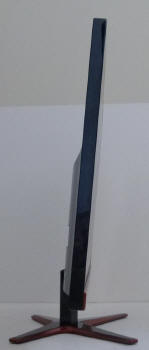
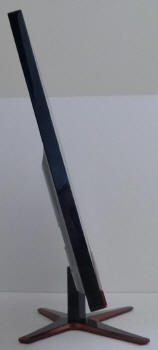
Above: full
range of tilt adjustment shown. Click for larger versions
The tilt function is smooth but a little
stiff to move, but it does offer a reasonable range of angles to choose from as
shown above. The screen is wobbly on the stand though as you move it
around so you probably won't want to adjust it regularly. There are
unfortunately no other ergonomic adjustments offered from the stand here
so there's no height, swivel or rotate offered. The limited stand is
certainly a weak point of this display.
A summary of the screens ergonomic adjustments
is shown below:
|
Function |
Range |
Smoothness |
Ease of Use |
|
Tilt |
Yes |
Smooth |
A little stiff |
|
Height |
n/a |
- |
- |
|
Swivel |
n/a |
- |
- |
|
Rotate |
n/a |
- |
- |
|
Overall |
Very limited range of
adjustments and no VESA mounting either. Stand is wobbly |
The materials were of a decent enough standard and the
build quality felt ok, let down a bit by the wobbly stand design and light,
plastic feel to everything. There was no audible noise from the screen,
even when conducting specific tests which can often identify buzzing issues.
The whole screen remained cool even during prolonged use as well which
was pleasing.

Above: rear
views of the screen showing connections. Click for larger version
The back of the screen provides a connection for
the power brick which is provided with the screen. There are then connections
for headphone out, audio in, dual-link DVI, DisplayPort and HDMI. There are no
USB ports offered on this model.

OSD Menu
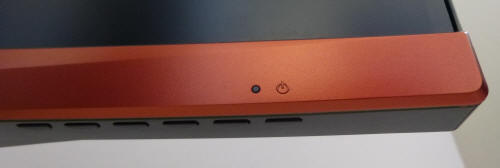
Above: OSD control buttons on the underneath edge in the bottom right hand corner. Click for larger
version
The OSD menu is accessed and controlled via a
series of 5 pressable buttons located on the bottom edge of the screen on the
right hand side. There is also a pressable on/off button with a small LED light
above it on the front of the bezel. This glows blue during normal operation and
amber in standby.

Pressing any of the buttons pops up the above
quick access menu. There are quick access options there for the eColor preset
modes, brightness control, overdrive setting and volume. The last option
enters the main OSD menu. Each of the quick access menus is shown below as
well:
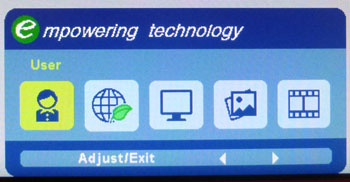
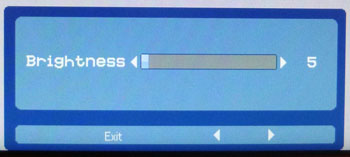
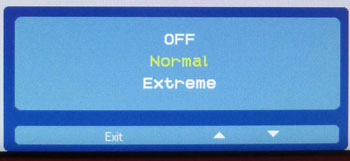
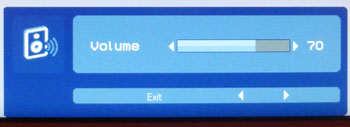
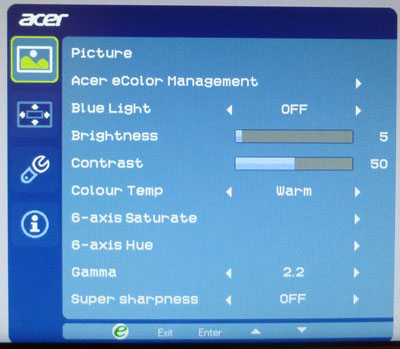
Pressing the last button brings up the main OSD
menu. This is split in to 4 sections down the left hand side, with the options
then shown on the right hand side for those sections. The first 'picture' menu
has most of the settings in it. There are options for brightness, contrast,
low blue light mode, colour temp, colour adjustment and gamma presets here.
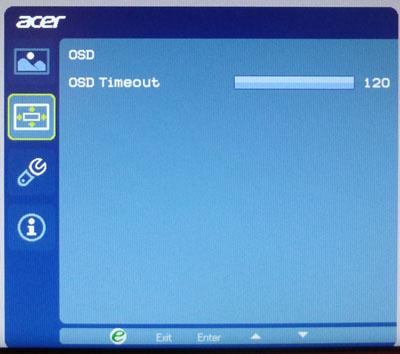
The second 'OSD' menu only has an option to control the timeout of the menu.
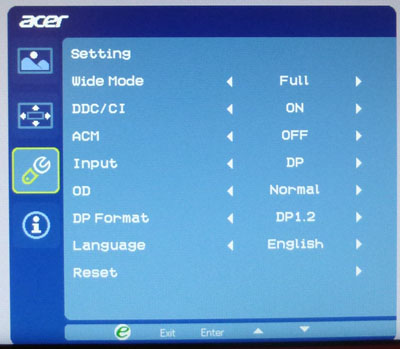
The third 'setting' menu has a few useful options. You can switch between the
different video inputs here although it is quite fiddly to get to this option
if you ever want to switch video input regularly. It's a shame you can't make
this one of the quick access options as drilling several layers into the OSD
menu each time gets annoying. You can alter the overdrive (OD) setting here,
although that's also available from the quick access menu. The aspect ratio
control options are also in this section with settings for full, aspect and
1:1 provided.
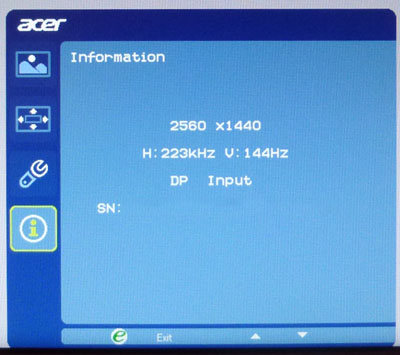
The final 'information' section confirms your current settings.
Overall the menu was quick and easy to navigate
and felt logical in layout. It was a bit annoying if you wanted to switch
inputs, and some of the settings (e.g. gamma presets) were quite limited.

Power Consumption
In terms of power consumption the manufacturer
lists maximum usage of 42.0W, minimum of 27.8W and 0.37W in standby. We carried out our normal tests to
establish its power consumption ourselves.
|
 |
|
State and Brightness
Setting |
Manufacturer Spec (W) |
Measured Power Usage
(W) |
|
Default (100%) |
42.0 |
47.9 |
|
Calibrated (16%) |
- |
23.2 |
|
Maximum Brightness (100%) |
- |
47.9 |
|
Minimum Brightness (0%) |
27.8 |
20.9 |
|
Standby |
0.37 |
1.2 |
|
We tested this ourselves and found that out of the
box the screen used 47.9W at the default 100% brightness setting. Once calibrated the screen reached
23.2W consumption, and in standby it
used only 1.2W. We have plotted these results below compared with other screens
we have tested. The consumption is comparable actually to the other W-LED
backlit displays we have tested, including competing gaming models like the Asus
ROG Swift PG278Q and BenQ XL2730Z. Larger screens (Dell U3415W, LG 34UM95)
and GB-r-LED backlit displays (e.g. ViewSonic VP2772) use a bit more than most W-LED backlights.


Panel and Backlighting
|
Panel Manufacturer |
AU Optronics |
Colour Palette |
16.7 million |
|
Panel Technology |
TN Film |
Colour Depth |
8-bit |
|
Panel Module |
M270DTN01.3 |
Colour space |
Standard gamut |
|
Backlighting Type |
W-LED |
Colour space coverage (%) |
~sRGB, ~72% NTSC |
Panel Part and Colour Depth
The Acer XG270HU features an
AU Optronics M270DTN01.3 TN Film technology panel which is capable of
producing 16.7 million colours. It is unclear whether this is a 6-bit+FRC module
(as most TN Film panels are), or an 8-bit panel (as the TN Film panel in the
Asus ROG Swift PG278Q is). We have been unable to confirm via a panel spec
sheet, although the Acer spec sheets list 8-bit which seems likely.
The panel part is confirmed when dismantling the
screen as shown
below. It should be noted that this is a slightly different
revision to the panel used in the
BenQ XL2730Z (M270DTN01.0), and different to that in the
popular
Asus ROG Swift PG278Q (M270Q002 V0) despite the similar specs of the screens.

Screen
Coating
The
screen coating is a medium anti-glare (AG) offering. It isn't a semi-glossy
coating, and isn't as light as some modern IPS type panels either. It's in
keeping with other TN Film panels we've tested. Thankfully it isn't a heavily
grainy coating like some old IPS panels feature, although there is some
graininess noticeable. It retains its anti-glare properties to avoid too many
unwanted reflections of a full glossy coating, but does not produce an too
grainy or dirty an image that some thicker AG coatings can. There were no
cross-hatching patterns visible on the coating
Backlight Type and Colour Gamut
The screen uses a White-LED (W-LED) backlight unit
which has become very popular in today's market. This helps reduce power
consumption compared with older CCFL backlight units and brings about some
environmental benefits as well. The W-LED unit offers a standard colour gamut
which is approximately equal to the sRGB colour space.
Anyone wanting to work with wider colour spaces would need to consider wide
gamut CCFL screens or the newer range of GB-r-LED type displays available
now. If
you want to read more about colour spaces and gamut then please have a read of
our
detailed article.
Backlight
Dimming and Flicker
We tested the screen to establish the methods used
to control backlight dimming. Our in depth article talks in more details about a
common method used for this which is called
Pulse Width Modulation (PWM). This in itself gives cause for concern to some
users who have experienced eye strain, headaches and other symptoms as a result
of the flickering backlight caused by this technology. We use a photosensor +
oscilloscope system to measure backlight dimming control
with a high level of accuracy and ease. These tests allow us to establish
1) Whether PWM is being used to control the
backlight
2) The frequency and other characteristics at which this operates, if it is used
3) Whether a flicker may be introduced or potentially noticeable at certain
settings
If PWM is used for backlight dimming, the higher
the frequency, the less likely you are to see artefacts and flicker. The duty
cycle (the time for which the backlight is on) is also important and the shorter
the duty cycle, the more potential there is that you may see flicker. The other
factor which can influence flicker is the amplitude of the PWM, measuring the
difference in brightness output between the 'on' and 'off' states. Please
remember that not every user would notice a flicker from a backlight using PWM,
but it is something to be wary of. It is also a hard thing to quantify as it is
very subjective when talking about whether a user may or may not experience the
side effects.
100% 50%
0%



Above scale = 1
horizontal grid = 5ms
At 100% brightness a constant voltage is applied
to the backlight. As you reduce the brightness setting to dim the backlight a
Direct Current (DC) method is used, as opposed to any form of PWM. This applies
to all brightness settings from 100% down to 0%. The screen is flicker free as
advertised, and as per a lot of Acer's new screens nowadays.
|
Pulse Width
Modulation Used |
No |
|
Cycling
Frequency |
n/a |
|
Possible
Flicker at |
|
|
100% Brightness |
No |
|
50% Brightness |
No |
|
0% Brightness |
No |
For an up to date list of all flicker-free (PWM free) monitors please see our
Flicker Free Monitor Database.

Contrast
Stability and Brightness
We wanted to see how much variance there was in
the screens contrast as we adjusted the monitor setting for brightness.
In theory, brightness and contrast are two independent parameters, and good
contrast is a requirement regardless of the brightness adjustment.
Unfortunately, such is not always the case in practice. We recorded the
screens luminance and black depth at various OSD brightness settings, and
calculated the contrast ratio from there. Graphics card settings were left at
default with no ICC profile or calibration active. Tests were made using an
X-rite i1 Display Pro colorimeter. It should be noted that we used the
BasICColor calibration software here to record these, and so luminance at
default settings may vary a little from the LaCie Blue Eye Pro report.
|
OSD
Brightness |
Luminance
(cd/m2) |
Black
Point (cd/m2) |
Contrast
Ratio
( x:1) |
|
100 |
361.61 |
0.42 |
861 |
|
90 |
323.52 |
0.38 |
851 |
|
80 |
288.07 |
0.34 |
847 |
|
70 |
252.66 |
0.29 |
871 |
|
60 |
215.81 |
0.25 |
863 |
|
50 |
195.48 |
0.23 |
850 |
|
40 |
173.12 |
0.20 |
866 |
|
30 |
153.04 |
0.18 |
850 |
|
20 |
131.16 |
0.15 |
874 |
|
10 |
107.24 |
0.13 |
825 |
|
0 |
85.46 |
0.10 |
855 |
|
Total Luminance Adjustment Range
(cd/m2) |
276.15 |
Brightness OSD setting controls backlight? |
 |
|
Total Black Point
Adjustment Range (cd/m2) |
0.32 |
|
Average Static Contrast Ratio |
856:1 |
PWM Free? |
 |
|
Recommended OSD setting
for 120 cd/m2 |
16 |
The brightness control gave us a very good range
of adjustment. At the top end the maximum luminance reached 362
cd/m2 which was
high, even a little more so than the specified maximum brightness of 350 cd/m2
from the manufacturer. There was a decent 276 cd/m2 adjustment range
in total, and so at the minimum setting you could reach down to a fairly low
luminance of 85 cd/m2. This should be adequate for those
wanting to work in darkened room conditions with low ambient light, although not
as dark as you can drive some screens. A setting of 16 in the OSD menu should return you a
luminance of around 120 cd/m2 at default settings in this preset mode
(standard).
It should be noted that the
brightness regulation is controlled without the need for
Pulse Width Modulation, using a Direct Current (DC) method for all
brightness settings between 100 and 0% and so the screen is flicker free as
advertised.

We have plotted the
luminance trend on the graph above. The screen behaves as it should in this
regard, with a reduction in the luminance output of the screen controlled by the
reduction in the OSD brightness setting. This is not a linear relationship as
you can see, with the settings from 100 to 60 controlling a steeper adjustment
curve than settings from 60 to 0.

The average contrast ratio of
the screen was good, but not excellent, for a TN Film panel with an average of
856:1. This was pretty stable across the brightness adjustment range as shown
above.

Testing
Methodology
An
important thing to consider for most users is how a screen will perform out of
the box and with some basic manual adjustments. Since most users won't have
access to hardware colorimeter tools, it is important to understand how the
screen is going to perform in terms of colour accuracy for the average user.
We restored our graphics card to default settings and disabled any previously active
ICC profiles and gamma corrections. The screen was tested at default factory settings using the DVI interface, and analysed using
an
X-rite i1
Pro Spectrophotometer (not to be confused with the i1 Display Pro
colorimeter) combined with
LaCie's Blue Eye Pro software suite. An X-rite i1 Display Pro colorimeter was
also used to verify the black point and contrast ratio since the i1 Pro
spectrophotometer is less
reliable at the darker end.
Targets for these tests are as follows:
-
CIE Diagram - validates the colour space
covered by the monitors backlighting in a 2D view, with the black triangle representing the
displays gamut, and other reference colour spaces shown for comparison
-
Gamma - we aim for 2.2 which is the default
for computer monitors
-
Colour temperature / white point - we aim
for 6500k which is the temperature of daylight
-
Luminance - we aim for 120
cd/m2, which is
the recommended luminance for LCD monitors in normal lighting conditions
-
Black depth - we aim
for as low as possible to maximise shadow detail and to offer us the best
contrast ratio
-
Contrast ratio - we aim
for as high as possible. Any dynamic contrast ratio controls are turned off here
if present
-
dE average / maximum -
as low as possible.
If DeltaE >3, the color displayed is significantly different from the
theoretical one, meaning that the difference will be perceptible to the
viewer.
If DeltaE <2, LaCie considers the calibration a success; there remains a
slight difference, but it is barely undetectable.
If DeltaE < 1, the color fidelity is excellent.

Default Performance and
Setup
Default settings of the screen were as follows:
|
Monitor OSD Option |
Default Settings |
|
eColor Management preset |
Standard |
|
Brightness |
100 |
|
Contrast |
50 |
|
Gamma |
2.2 |
|
Colour Temperature |
Warm |
|
RGB |
n/a |

Acer XG270HU - Default Settings




|
|
Default Settings |
|
luminance (cd/m2) |
386 |
|
Black Point (cd/m2) |
0.45 |
|
Contrast Ratio |
861:1 |
Initially out of the box the screen was set in the
default 'standard' eColor Management preset mode with gamma mode of 2.2, and
colour temperature of 'warm'. To the naked eye the screen felt very bright as it
was also at its default 100% brightness setting, and it felt a little washed
out. We went
ahead and measured the default state with the i1 Pro. The
CIE diagram on the left of the image confirms that the monitors colour gamut
(black triangle) is roughly equal to
the sRGB colour space. There is some minor over-coverage in green and blue shades but not by anything
too massive.
Default gamma was recorded at 1.8 average, leaving it with a
16% deviance
from the target. Keep in mind this screen is aimed at gaming uses and so a
large deviance from the 2.2 you'd normally want to use for desktop use is not
too much of a
surprise. White point was measured at 6411k, leaving it only 1% out from the
6500k we'd ideally want for desktop use which was pleasing.
Luminance was recorded at a very bright 386
cd/m2 which is
too high for prolonged general use. The screen was set at a default 100%
brightness in the OSD menu but that is easy to change of course to reach a more
comfortable setting without impacting any other aspect of the setup. The black
depth was 0.45 cd/m2 at this default
brightness setting, giving us a decent static contrast ratio of 856:1 for a TN
Film panel.
Colour accuracy was not great due to
the 1.8 gamma. There was an average dE of 3.8 and maximum
of 6.6. Testing the screen with various gradients showed no banding thankfully. There was some
obvious gradation evident
in darker tones.
Unfortunately on this screen there is no easy way
to correct the gamma curve, since there are only options in the OSD menu for
gamma modes 2.2 and 1.8 (the latter moving it even further away from 2.2). A
calibration tool, or perhaps our calibrated ICC profile is going to be required to correct that on this screen if you
want to use it for more general uses reliably.

Calibration
We used the
X-rite i1 Pro spectrophotometer combined with the LaCie Blue Eye Pro
software package to achieve these results and reports. An X-rite i1 Display Pro
colorimeter was used to validate the black depth and contrast
ratios due to lower end limitations of the i1 Pro device.
|
Monitor OSD Option |
Calibrated Settings |
|
Preset Picture Mode |
User |
|
Brightness |
16 |
|
Contrast |
50 |
|
Gamma |
2.2 |
|
Colour Temperature |
User |
|
RGB |
97, 90, 98 |

Acer XG270HU - Calibrated Settings

|
|
Calibrated Settings |
|
luminance (cd/m2) |
121 |
|
Black Point (cd/m2) |
0.15 |
|
Contrast Ratio |
828:1 |
When you change any setting in the OSD menu,
including brightness, it changes you out of the 'standard' eColor mode and in to
the 'user' mode. From there we switched to the 'user' colour temperature mode as
well which
would give us access
to the RGB channels. Altering these OSD
settings allowed us to obtain an
optimum hardware starting point and setup before software level changes would be
made at the graphics card level. We left the LaCie software to calibrate
to "max" brightness which would just retain the luminance of whatever brightness
we'd set the screen to, and would not in any way try and alter the luminance at
the graphics card level, which can reduce contrast ratio. These adjustments
before profiling the screen would help preserve tonal values and limit
banding issues. After this we let the software carry out the LUT adjustments and create an
ICC profile.
Average gamma was now corrected to 2.2 average
with a 0% deviance,
correcting the large 16% deviance we'd seen out of the box. The
minor 1% white point deviance had now been corrected, bringing it in line with the
target at 6520k. Luminance had been improved thanks to the adjustment to the
brightness control and was now being measured at 121
cd/m2. This
left us a black depth of 0.15 cd/m2 and gave us a fairly decent static
contrast ratio (for a TN Film panel) of
828:1. Colour accuracy of the resulting
profile was excellent, with dE average of 0.4 and maximum of 0.8. LaCie would
consider colour fidelity to be very good overall.
Testing the screen with various colour gradients
showed mostly smooth transitions. There was some slight gradation in darker tones
but no banding introduced due to the adjustments to the
graphics card LUT from the profilation of the screen which was pleasing.
You can use our settings and
try our calibrated ICC profile if you wish, which are available in
our ICC profile database. Keep in mind that results will vary from one
screen to another and from one computer / graphics card to another.

Calibration Performance Comparisons

The comparisons made in this section try to give
you a better view of how each screen performs, particularly out of the box which
is what is going to matter to most consumers. When comparing the default factory
settings for each monitor it is important to take into account several
measurement areas - gamma, white point and colour accuracy. There's no point
having a low dE colour accuracy figure if the gamma curve is way off for
instance. A good factory calibration requires all 3 to be well set up. We have
deliberately not included luminance in this comparison since this is normally
far too high by default on every screen. However, that is very easily controlled
through the brightness setting (on most screens) and should not impact the other
areas being measured anyway. It is easy enough to obtain a suitable luminance
for your working conditions and individual preferences, but a reliable factory
setup in gamma, white point and colour accuracy is important and not as easy to
change accurately without a calibration tool.
From these comparisons we can also compare the
calibrated colour accuracy, black depth and contrast ratio. After a calibration
the gamma, white point and luminance should all be at their desired targets.

Default setup of the screen out of the box was not
ideal for day to day normal uses, with the gamma being the main area of
weakness. It is set up more for gaming needs with a 1.8 average, 16% out from
our 2.2 target. This is a gaming screen keep in mind so it is perhaps not
surprising, but with the lack of any useful gamma controls from the OSD it is
tricky to adjust without a calibration tool. Our calibrated ICC profile may
assist of course but ideally you'd want your own calibration device if you want
to set the screen up more accurately for normal uses. The white point was at
least close to the 6500k target and contrast ratio was decent enough for a TN
Film panel out of the box at 861:1.


The display offered reasonable contrast ratios
after calibration at 828:1. This was a little lower than we'd seen from some other recent TN
Film models we've tested like the
BenQ XL2730Z (917:1) and
Asus ROG Swift PG278Q (858:1), but not by
much. Of course
it can't compete with VA panel types which can reach over 2000:1 easily, and
commonly up to 3000:1, even close to 5000:1 in the case of the
Eizo FG2421.
|
Check Pricing and Buy - Direct Links
|
|
Amazon USA |
Amazon UK |
Amazon GER |
Amazon CAN
|
|
TFTCentral is a participant
in the Amazon Services LLC Associates Programme, an affiliate
advertising programme designed to provide a means for sites to earn
advertising fees by advertising and linking to Amazon.com, Amazon.co.uk,
Amazon.de, Amazon.ca and other Amazon stores worldwide. We also
participate in a similar scheme for Overclockers.co.uk. |

Viewing Angles

Above: Viewing
angles shown from front and side, and from above and below. Click for
larger image
Viewing angles of the screen were as you might
expect from a TN Film panel. Unfortunately this panel technology is inherently
poor in this field, and so viewing angles are more restrictive than other
competing technologies like IPS and VA variants. Although the manufacturer will
quote a viewing angle of 170 / 160 (a classic indication that a TN Film panel is
being used by the way if in doubt), in practice there are some obvious contrast
and colour tone shifts horizontally, and especially vertically.
As you move your head from side to side in a
horizontal plane, there is a contrast shift and the image becomes darker and
introduces a slight green/yellow hue. As you move to a wider angle the image can
become more washed out as well. Vertically the fields of view are more
restrictive still. From above the image becomes very pale and washed out, while from
below there is a characteristic TN Film darkening of the image. Unfortunately
vertically the viewing angles will introduce noticeable shifts in the contrast
and colour tone of the image which mean that for any colour critical work it is
not really very well suited. TN Film panels have long suffered from these
restrictive viewing angles due to the nature of their pixel structure. They are
still fine for a single user for general use and certainly the TN Film panels
offer their advantages when it comes to
pixel response
times and refresh rate for gaming. If however, you were hoping to do any
colour critical or photography work you may find these shifts in the appearance
of the image difficult. An IPS-type panel would probably be a wiser choice if
you were looking for a screen with much wider viewing angles but having said
that you are probably mainly interested in gaming if you are considering this
screen. Remember, the XG270HU is specifically designed for gaming, and so you
will have to live with some of the sacrifices of TN Film to get the kind of
gaming performance and features offered here.
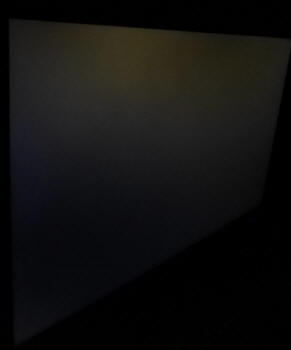
Above: View of an
all black screen from the side. Click for larger version
On a black image there is a moderate pale grey tint
introduced to the image when viewed from a wide angle. This isn't too severe and
shouldn't present any real problems in practice. Certainly not the obvious white
glow you get from most modern IPS-type panels in similar situations and fairly
standard for a TN Film panel.

Panel Uniformity
We wanted to test
here how uniform the brightness and colour temperature was across the screen, as well as identify any
leakage from the backlight in dark lighting conditions. Measurements of the luminance
and colour temperature were taken at 35 points across the panel on a pure
white background. The measurements for luminance were taken using BasICColor's calibration
software package, combined with an X-rite i1 Display Pro
colorimeter with a central point on the screen calibrated to 120 cd/m2. Measurements for colour temperature (white point) were taken using
BasICColor software and the i1 Pro spectrophotometer which can more accurately
measure the white point of different backlighting technologies. The below uniformity diagram shows the difference, as a percentage,
between the measurement recorded at each point on the screen, as compared with the
central reference point.
It is worth
noting that panel uniformity can vary from one screen to another, and can depend
on manufacturing lines, screen transport and other local factors. This is only a
guide of the uniformity of the sample screen we have for review.

Uniformity of Luminance

The luminance uniformity of the screen was
reasonable. There was a drop in luminance
in the lower right hand corner, where it dropped down to 98
cd/m2
in the most severe example. Around two thirds of the screen was within a 10%
deviance of the centrally calibrated point.

Backlight Leakage
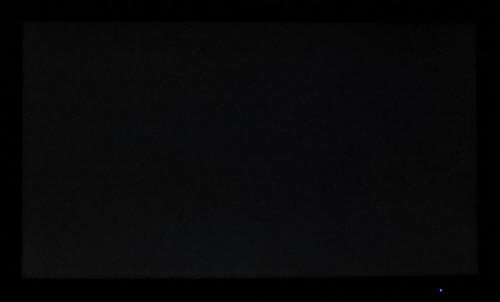
Above: All black screen in a darkened room. Click for larger version
As usual we also tested the screen with an all
black image and in a darkened room. A camera was used to capture the result. The
camera showed there was very little in the way of bleeding or clouding from the
backlight. The bottom corners were a little lighter, but you couldn't really
spot this with the naked eye. In normal uses there was no issue at
all.

General and Office Applications
The XG270HU feature a large 2560 x 1440 WQHD
resolution which is still pretty rare for gaming 27" screens. There's only been
a few released so far - the Asus ROG Swift PG278Q (G-sync TN Film), Acer XB270HU
(G-sync and IPS) and the BenQ XL2730Z (FreeSync TN Film). So in this space
there's still a limited choice when it comes to high resolution gaming screens,
with most other models still offering only 1920 x 1080. This extra resolution is
excellent both for gaming and for other uses.
The pixel pitch of 0.233 mm is quite small as a result
though, and by comparison a
standard 16:10 format 24" model has a pixel pitch of 0.270mm and a 30" model has
0.250mm. These ultra-high resolution 27" models offer a tight pixel pitch and
therefore small text as well. We found it quite a change originally coming from
21.5 - 24" sized screens back in the day, even those offering quite high
resolutions and small pixel pitches. Although now we are very used to working
with 27" 1440p screens all the time and find them very comfortable and a
significant upgrade over 1080 / 1200p models. Some users may find the small text
a little too small to read comfortably, and we'd advise caution if you are
coming from a 19" or 22" screen for instance where the pixel pitch and text are
much larger. The extra screen size takes some getting used to over a few days as
there really is a lot of room to work with but once you do, it's excellent. For
those wanting a high resolution for their work, this is a
really good option. The image was very sharp and crisp and text was very clear.
With its
WQHD display, you enjoy 77% more desktop space than a full HD screen to spread
out your windows and palettes.
The
frameless thin
bezel design mean that the XG270HU could be easily integrated into a
multi-screen set up if you wanted. The moderate AG coating of the
TN Film panel could be considered a bit grainy, especially on white office
backgrounds to a lot of people. It's not as clear as modern IPS coatings or any
semi-glossy solution. Still, it's not as grainy as old IPS panels and is on par
with other TN Film matrices we've tested. Perhaps the main issue with this panel
technology though is the restrictive viewing angles, making contrast and colour
tone shifts a bit of a problem when it comes to colour critical work. They are
the same here as other TN Film panels, being restrictive especially vertically.
The screen is fine when viewed head on though really for office and text work,
but for colour critical work or photo editing etc you'd be better off with an
IPS-type panel.
The default setup of the screen was a bit restrictive for normal uses, as the
gamma is set up more for gaming, and hard to adjust without a calibration tool
(or maybe our calibrated ICC profile).
The brightness
range of the screen was very good, with the ability to offer a luminance between
362 and 85 cd/m2. This should mean the screen is perfectly
useable in a wide variety of ambient light conditions, including darkened rooms
although we would have maybe hoped for a slightly lower minimum luminance value.
A setting of ~16 in the OSD brightness control should return you a luminance
close to 120 cd/m2 out of the box. On another positive note, the brightness
regulation is controlled without the need for the use of the now infamous
Pulse-Width Modulation (PWM), and so those who suffer from eye fatigue or
headaches associated with flickering backlights need not worry. There is also an
additional Low Blue Light mode which is a useful extra.
There was no
audible noise or buzzing from the screen, even when specifically looking for it
using test images with a large amount of text at once. The screen also remains
cool even during prolonged use. There are limited extras offered on this screen
with audio input, headphone socket and integrated basic speakers being about the
only things provided. There's sadly no USB ports here which we do miss, or
anything like ambient light sensors
or card readers which can be useful in office environments. This is primarily a
gaming screen remember. There was also a very limited range of ergonomic
adjustments available from the stand with only tilt adjustment offered. There
isn't a VESA mount option either so you're stuck with the stand on this screen.
The whole thing was also pretty wobbly on the stand if you need to use the OSD
menu or move it around.

Above: photo of
text at 2560 x 1440 (top) and 1920 x 1080 (bottom)
The screen is designed to run at its native
resolution of 2560 x 1440 and at a 144Hz recommended refresh rate. However,
if you want you are able to run the screen outside of this resolution. We tested
the screen at a lower 1920 x 1080 resolution to see how the screen handles the
interpolation of the resolution, while maintaining the same aspect ratio of
16:9. At native resolution the text was very sharp and clear. When running at a 1080p resolution the text is still
nice and clear, with low
levels of blurring. You do lose some screen real-estate as well of course but
the image seems to be interpolated quite well from 1080p sources. That's a good
sign if you need to game at a lower resolution due to the demands on your system
of a high refresh rate.

Gaming Introduction
The Acer XG270HU is an interesting screen to test
when it comes to gaming. It's only the third 27" gaming screen available with a
2560 x 1440 resolution and TN Film panel. The first one released being the extremely popular
Asus ROG Swift PG278Q we tested in July 2014. That was a TN Film based
model with 1ms G2G response time, 144Hz refresh rate and NVIDIA's G-sync
technology. Very recently in April 2015 we tested the
BenQ
XL2730Z with a
similar (not identical) panel, with the same 1ms G2G response time and 144Hz
refresh rate support. That model was the first screen we've tested using AMD's
new FreeSync technology and offered a massive range of BenQ gaming features.
The XG270HU should not be confused with the
similarly named
XB270HU model from Acer. That is an IPS-type screen with 144Hz and NVIDIA
G-sync support. This model is a TN Film model with 144Hz, 1ms G2G and FreeSync
support.
It should be noted that this screen does not
feature any added blur reduction mode, as that is not a feature of FreeSync like
it is on NVIDIA's G-sync module. Acer have not added their own blur reduction
mode here, unlike BenQ who added one separately to the XL2730Z.
|
Panel technology |
TN Film |
|
Refresh Rate |
144Hz |
|
FreeSync support |
 |
|
Blur Reduction mode |
 |
|
NVIDIA 3D Vision |
 |
To make the most of this screen you will want to
have a
suitable AMD graphics card which supports Adaptive Sync/FreeSync. That
will allow you to use one of the most interesting new features of this latest
screen. One of the key selling points of FreeSync is that unlike G-sync it does
not add a massive cost overhead to the display, and so actually even if you
don't have a suitable graphics card to use FreeSync you can still benefit from everything else
this screen has to offer. Don't forget there's a significant change when it
comes to resolution compared with the older XL models here. It should be noted that the screen can also be
used from NVIDIA graphics cards without issue, and there's a good range of
connectivity options provided to suit whatever card you've got. Again, you won't be
able to use FreeSync, but everything else should work fine.
We expect if you're looking at such a high end
gaming display that you will also have a pretty high end gaming PC to run it, so
2560 x 1440 at 144Hz would of course be preferable over anything else. That will
give you the highest frame rate and smoothest motion in gaming. We hope you have a system powerful enough to run this screen
at its intended 2560 x 1440 resolution and 144Hz refresh rate, as really that's
where you will get the optimum performance. You do need to consider the power of
your graphics card though as there will be a big demand on your system for
gaming at these kind of settings. Fortunately though there is also the new AMD
FreeSync technology which will offer you smooth gaming even at lower frame
rate outputs. Read on for more information.

Responsiveness and Gaming
|
Quoted G2G Response Time |
1ms G2G |
|
Quoted ISO Response Time |
n/a |
|
Panel Manufacturer and
Technology |
AU Optronics |
|
Panel Part |
M270DTN01.3 |
|
Overdrive Used |
Yes |
|
Overdrive Control Available to
User |
OD |
|
Overdrive Settings |
Off, Normal, Extreme |
The XG270HU is rated by Acer as having a 1ms G2G response time, which indicates the panel uses
overdrive /
response time compensation (RTC) technology to boost pixel transitions
across grey to grey changes. There is user control over the overdrive impulse
within the OSD menu using the 'AMA' (Advanced Motion Accelerator) option. The
part
being used is the
AU Optronics M270DTN01.3 TN Film panel. This is a very similar panel to that
used in the
BenQ XL2730Z, which was the M270DTN01.0. Have a read about response time in
our
specs section if you need additional information about this measurement.
We will first test the screen using our thorough
response time testing method. This uses an oscilloscope and photosensor to
measure the pixel response times across a series of different transitions, in
the full range from 0 (black) to 255 (white). This will give us a realistic view
of how the monitor performs in real life, as opposed to being reliant only on a
manufacturers spec. We can work out the response times for changing between many
different shades, calculate the maximum, minimum and average grey
to grey (G2G) response times, and provide an evaluation of any overshoot present
on the monitor.
We use an
ETC M526
oscilloscope for these measurements along with a custom photosensor device.
Have a read of
our response time measurement article for a full explanation of the testing methodology and reported
data.
Response Time (OD) Setting Comparison


The XG270HU comes with a user control for the
overdrive impulse available within the OSD menu in the 'setting' section as
shown above. There is also quick access to it from the menu. There are 3 options available here under the
OD (Overdrive) option in
the menu for Off, Normal and Extreme. First of all we carried out a smaller sample set
of measurements in all three of the OD response time settings. These, along with various
motion tests allowed us to quickly identify which was the optimum overdrive setting
for this screen.
For completeness we tested the response times in each of these
OD modes at various refresh rates, ranging from a normal 60Hz, up to the maximum
144Hz. This allowed us to establish if there were any differences in response
time behaviour at each refresh rate as well. Since FreeSync will by its nature
dynamically control the refresh rate, it's important to establish if there is
any impact on pixel response time behaviour when it does. We will say up front
now to save time that there was practically no difference in pixel response
time/overshoot behaviour between each refresh rate setting. The tests shown
below are at 144Hz for reference, but it made no difference really over 60Hz or
anything in between.

Firstly we tested the response times with OD set
to Off. Average G2G was pretty slow for a modern TN Film panel at 7.7ms, with
some transitions ranging up to 11 - 15ms. The overdrive impulse was turned off
here and so there was at least no overshoot at all. With response times being
slow though, you will almost certainly want to push for a higher setting which
is common on most screens. Note that even at 7.7ms G2G, this is still faster
than all the decent IPS-type 60Hz screens which reach about 8.5ms G2G at best
(without overshoot being an issue) so it's not exactly "slow".

We switched up to the middle 'Normal' setting and
tested again. Response times had been improved nicely, dropping from the 7.7ms G2G average we'd seen before to
4.0ms. Some transitions reached down to as
low as 1.1ms so the screen just about lives up to its spec as well in this mode
(it reaches 1.0ms in Extreme mode below). There were some
transitions which now showed some low levels of overshoot, but surprisingly very
little at all. Normally you have to make do with some fairly moderate levels of
overshoot on a lot of
fast TN Film screens when you push them to the optimum response time setting.
Thankfully Acer haven't been too aggressive here and so only a little is
introduced.

The highest 'Extreme' setting improved response
times a bit further down to 2.9ms G2G average. The problem is that the overshoot
become much higher and far more noticeable. It was to an extent that made this
OD mode too aggressive. We would recommend sticking to the Normal mode.

If we take some test photos using the PixPerAn
tool you can make some further visual comparisons between the overdrive
settings. With OD off the slower response times lead to some low levels of
motion blur. It's not actually a massive amount as even with an 7.7ms G2G
response time measured it's a little faster than a decent IPS-type panel anyway.
Once you turn the OD setting up to Normal the blurring is reduced nicely and
quite noticeably, with
the moving image becomes sharper and clearer. Some minor slight dark trailing is
evident but it's hard to spot in these tests. If you switch up to the Extreme OD setting the overshoot does become very
apparent, and there's a dark and pale halo behind moving objects. Definitely
better to stick with the Normal OD setting.
Important - see our
FreeSync section of the review regarding some limitations with OD settings
when paired with a FreeSync graphics card/driver/connection at this time.

More Detailed Measurements -
OD Normal
Having established that the OD Normal mode offered
the best response/overshoot balance we carried out our normal wider range of
measurements as shown below. Tests were completed at the maximum 144Hz refresh
rate although the refresh rate made no real difference to the response times
anyway.
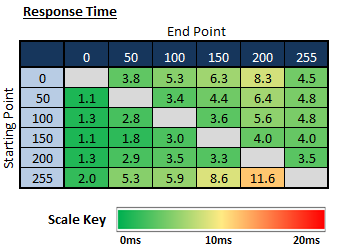 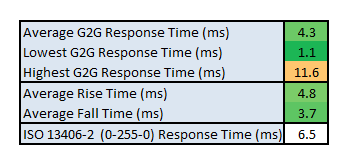
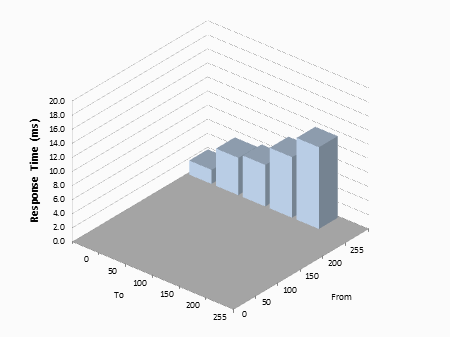
The average G2G response time was more accurately
measured at 4.3ms which was very good overall. Rise times were slightly slower
than fall times but not by anything significant. Some measurements reached
almost as low as the advertised 1ms figure as well, at 1.1ms minimum. There was
one problematic transition which was slower at 11.6ms (255-200) for some odd
reason.
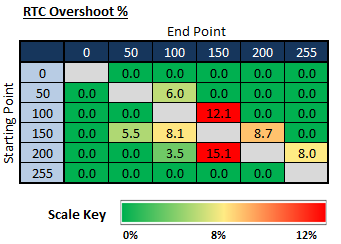
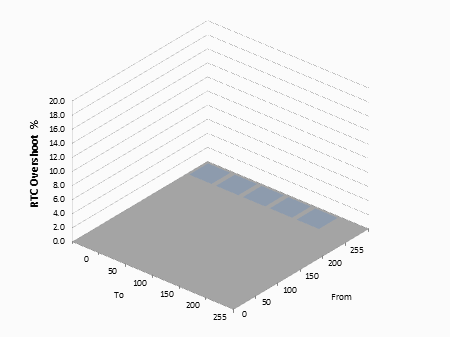
There was some overshoot introduced
unfortunately at this OD level, but it was pretty low overall. It wasn't too severe, and certainly less
than if you push OD up to the maximum Extreme mode. Still, a couple of transitions
showed pretty high overshoot values. It was however better than we've seen
from other fast TN Film models including the BenQ XL2730Z and Asus
ROG Swift PG278Q. There was less overshoot here on the Acer screen which was
pleasing.
Important - see our
FreeSync section of the review regarding some limitations with OD settings
when paired with a FreeSync graphics card/driver/connection at this time.

Display Comparisons
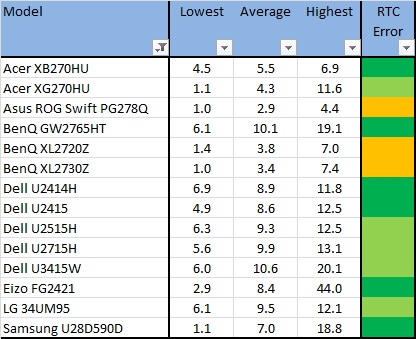
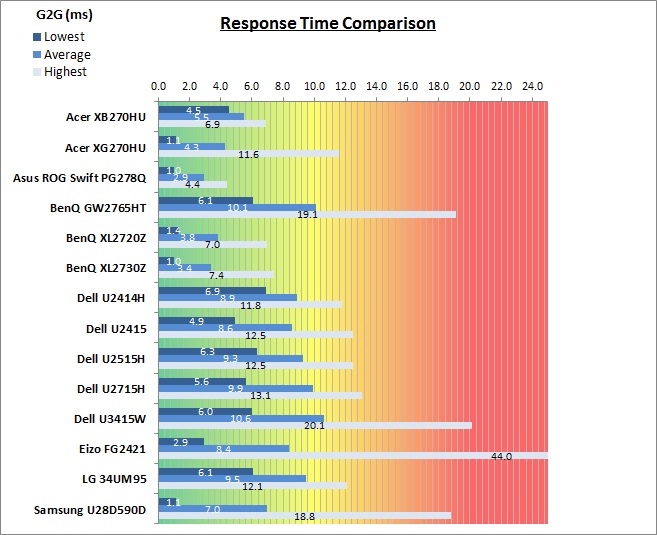
The above comparison table and graph shows you the
lowest, average and highest G2G response time measurement for each screen we
have tested with our oscilloscope system. There is also a colour coded mark next
to each screen in the table to indicate the RTC overshoot error, as the response
time figure alone doesn't tell the whole story.
The response time performance of the XG270HU was
comparable with other fast TN Film screens we've tested of late. With a 4.3ms
G2G response time It's a little slower than the Asus ROG Swift PG278Q (2.9ms)
and BenQ XL2730Z (3.4ms) but delivers less overshoot which is arguably a little
better overall. We prefer the fact Acer have toned down the overdrive impulse a
little to reduce overshoot when using OD Normal as compared with a lot of
screens at their optimum response time setting.
The screen was also tested using the chase test in
PixPerAn for the following display comparisons. As a reminder, a series of
pictures are taken on the highest shutter speed and compared, with the best case
example shown on the left, and worst case example on the right. This should only
be used as a rough guide to comparative responsiveness but is handy for a
comparison between different screens and technologies as well as a means to
compare those screens we tested before the introduction of our oscilloscope
method.

27"
1ms
G2G AU Optronics TN Film @ 144Hz (OD = Normal)
In practice the Acer XG270HU performed best with
the OD overdrive setting on 'Normal'. Motion blur was minimal and the moving image
looked sharp and crisp. Motion felt very fast and fluid thanks to the 144Hz
refresh rate, something which you can't really pick out with the camera in these
specific tests. There
was some slight overshoot detected in the form of some dark trailing but it was
not distracting, and compared to some other fast TN Film screens we've seen, a
little lower.

27"
1ms
G2G AU Optronics TN Film @ 144Hz (OD = Normal)

27"
1ms
G2G AU Optronics TN Film @ 144Hz (AMA = High)

27"
1ms
G2G AU Optronics TN Film @ 144Hz (OD = Normal)
If we compare the XG270HU to the other two 2560 x
1440 resolution TN Film gaming screen we've tested the similarities are quite
obvious. All three models offered very low response times, and in practice it
was very difficult to spot any real difference in smoothness or blurring. The
Acer did show slightly less overshoot though and the dark trails were a little
less pronounced which was pleasing. We know from our oscilloscope tests that
there is less overshoot on this model and we can see that visually in motion
tests.

27"
1ms
G2G AU Optronics TN Film @ 144Hz (OD = Normal)

27" 8ms G2G
LG.Display AH-IPS

27"
8ms
G2G LG.Display AH-IPS (Response Time = Normal)

27" 4ms G2G AU
Optronics AHVA (AMA Setting = High)
It is interesting to compare the XG270HU against some of the other popular 27"
models we have tested with 2560 x 1440 resolutions, this time with IPS-type panels.
The Dell U2713HM
is about as fast as you can get from a 60Hz IPS screen at the moment, with an
8.5ms G2G response time and no overshoot detected. The
Dell U2715H and
BenQ BL2710PT are a little slower at around 10ms G2G and so there is a more
noticeable blurring to the image. Overall the XG270HU feels snappier and faster
than these other models because of its much higher refresh rate. While the
response times are low enough on models like the U2713HM to produce pretty low
levels of motion blur, you are still limited by the refresh rate of the screen.
Once you reach levels where the response time is sufficiently low to not be a
major factor in blurring, you get a far more effective elimination of motion
blur by increasing the refresh rate or adding additional blur reduction
techniques. If you have a look at our following sections with the
pursuit camera
you can see what a difference it makes bumping the refresh rate up from 60Hz to
144Hz in actual perceived motion blur.

27"
1ms
G2G AU Optronics TN Film @ 144Hz (OD = Normal)

27"
4ms
G2G AU Optronics AHVA (IPS-type) @ 144Hz (OD = Normal)

23.5" 4ms G2G
Sharp MVA + 120Hz
We've also included a comparison above against
a couple of non TN Film gaming screens we've tested. Then there is a comparison
against the excellent
Acer Predator XB270HU, the World's first 144Hz IPS-type panel. This had very
low response times for an IPS panel, not quite as low as the TN Film screens
here but offsetting that slightly higher response time is the fact that it has
no overshoot at all! This screen also benefits from the high frame rates and has
support for NVIDIA G-sync and ULMB as well.
Then there is the MVA based Eizo FG2421 screen
with a fairly fast response time (especially for the panel technology being
used) and 120Hz refresh rate support. There is also an additional 'Turbo 240'
motion blur reduction mode which really helps reduce the perceived motion blur
in practice.

FreeSync
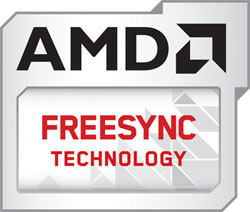
Obviously a huge part of the Acer XG270HU is
the addition of the new AMD FreeSync technology, their branded version of the VESA standard
Adaptive Sync. It's a competing technology to NVIDIA's already
available G-sync and so the principles of its operation remain the same. We've
discussed G-sync in our
Asus ROG Swift PG278Q and
Acer XB270HU reviews already in detail, and we've also recently looked at
FreeSync when we reviewed the
BenQ XL2730Z during April 2015. Some content in this section is copied from
the BenQ review to save you reading it there, but if you've read the BenQ
XL2730Z review you may want to skip over the FreeSync overview/operation
sections.
As an introduction,
monitors typically operate
at a fixed refresh rate, whether that is 60, 120 or 144Hz. When running
graphically intense content like games, the frame rate can of course fluctuate
somewhat and this poses a potential issue to the user. There are traditionally
two main options available for how frames are passed from the graphics card to
the monitor using a feature called VSYNC, whether Vsync is turned on or off. The
first diagram below come from NVIDIA's G-sync content but we will leave them in
to demonstrate how V-sync works as the same principles apply here when talking
about FreeSync.
Vsync Overview
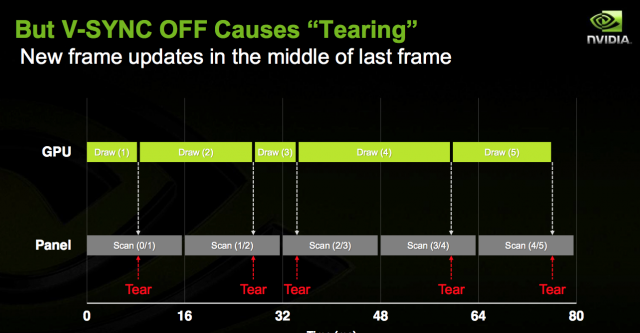
At the most basic level
‘VSync
OFF’
allows the GPU to send frames to the monitor as soon as they have been
processed, irrespective of whether the monitor has finished its refresh and is
ready to move onto the next frame. This allows you to run at higher frame rates
than the refresh rate of your monitor but can lead to a lot of problems. When
the frame rate of the game and refresh rate of the monitor are different, things
become unsynchronised. This lack of synchronisation coupled with the nature of
monitor refreshes (typically from top to bottom) causes the monitor to display a
different frame towards the top of the screen vs. the bottom. This results in
distinctive
‘tearing’
on the monitor that really bothers some users. Even on a 120Hz or 144Hz monitor,
where some users incorrectly claim that there is no tearing, the tearing is
still there. It is generally less noticeable but it is definitely still there.
Tearing can become
particularly noticeable during faster horizontal motion (e.g. turning, panning,
strafing), especially at lower refresh rates.
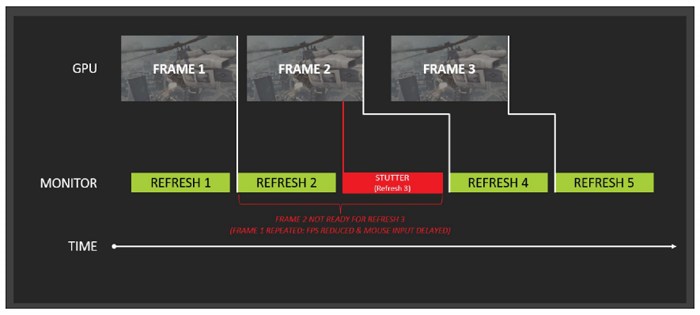
The solution to this tearing problem for many
years has been the
‘VSync
ON’
option which essentially forces the GPU to hold a frame until the monitor is
ready to display it, as it has finished displaying the previous frame. It also
locks the frame rate to a maximum equal to the monitor’s refresh rate. Whilst
this eliminates tearing, it also increases
lag
as there is an inherent delay before frames are sent to the monitor. On a 120Hz
monitor the lag penalty is half that of a 60Hz monitor and on a 144Hz
monitor is even lower. It is still there, though, and some users feel it
disconnects them from game play somewhat. When the frame rate drops below the
refresh rate of the monitor this disconnected feeling increases to a level that
will bother a large number of users. Some frames will be processed by the GPU more slowly than the monitor is able to display them. In other words the
monitor is ready to move onto a new frame before the GPU is ready to send it. So
instead of displaying a new frame the monitor displays the previous frame again,
resulting in
stutter.
Stuttering can be a major problem when using the Vsync on option to reduce
tearing.
During Vsync ON operation, there can also
sometimes be a sudden slow down in frame rates when the GPU has to work harder.
This creates situations where the frame rate suddenly halves, such as 60 frames
per second slowing down to 30 frames per second. During Vsync ON, if your
graphics card is not running flat-out, these frame rate transitions can be very
jarring. These sudden changes to frame rates creates sudden changes in lag, and this can disrupt
game play, especially in first-person shooters.
Variable Refresh Rate - Adaptive-Sync
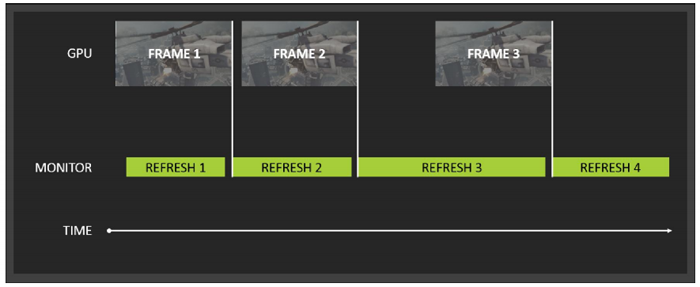
To overcome these
limitations with Vsync, both NVIDIA and AMD have introduced new technologies
dubbed G-sync and FreeSync respectively. We've already seen G-sync used for
quite a few months now with great success. The BenQ XL2730Z will be the first
screen we've tested featuring AMD's version as FreeSync was only launched on
March 19th 2015. The idea of both technologies is based on variable refresh
rates. These technologies can be integrated into monitors allowing them to
dynamically alter the monitor refresh rate depending on the
graphics card output and frame rate. The frame rate of the monitor is still
limited in much the same way it is without a variable refresh rate technology,
but it adjusts dynamically to a refresh rate to match the frame rate of the game. By doing this
the monitor refresh rate is perfectly synchronised with the GPU. You don’t get
the screen tearing or visual latency of having Vsync disabled, nor do you get
the stuttering or input lag associates with using Vsync. You can get the benefit
of higher frame rates from Vsync off
but without the tearing, and without the lag and stuttering caused if you switch
to Vsync On.
G-Sync vs. FreeSync
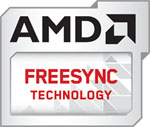
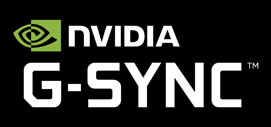
Both G-sync and FreeSync operate on this principle
of dynamically controlling the refresh rate. There's a few differences between
how the technology is implemented though. NVIDIA G-sync requires a proprietary
G-sync module to be added to the monitor, which comes at quite a high cost
premium. You will notice as a result that the retail price of compatible G-sync
monitors is often £100 - 200 higher than similar competitors because of this
module. There is another limitation with adding a G-sync module in that it is
only designed to work with a single interface currently, and so supporting monitors only
offer a single DisplayPort connection. That makes those monitors somewhat
restrictive when it comes to attaching any other devices of computers. The
screens are also provided without a scaler, and so hardware aspect ratio control
options are not offered. That's not as important as on some screens given you
are restricted to a single DP interface anyway, and the PC can handle the
scaling for you. It does also mean that signal processing lag is incredibly low
as a result, another positive for gaming.
G-sync modules also support a native blur
reduction mode dubbed ULMB (Ultra Low Motion Blur). This allows the user to opt
for a strobe backlight system if they want, in order to reduce perceived
motion blur in gaming. It cannot be used at the same time as G-sync since
ULMB operates at a fixed refresh rate only, but it's a useful extra option for
these gaming screens. Of course
since G-sync/ULMB are an NVIDIA technology, it only works with specific G-sync compatible NVIDIA
graphics cards. While you can still use a G-sync monitor from an AMD/Intel
graphics card for other uses, you can't use the actual G-sync or ULMB functions.
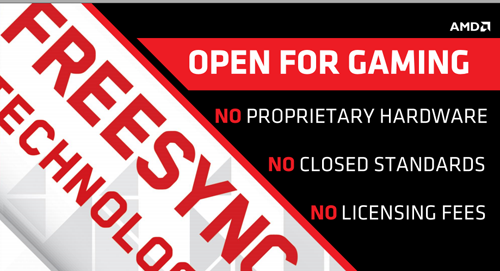
On the other hand AMD FreeSync technology costs
virtually nothing for a monitor manufacturer to adopt and so there is no price
premium really for supporting monitors, hence the name. Most of them already had the relevant
components in their supply chains, but need the right software to come along to
expose latent capabilities. With the help of VESA, the DisplayPort Adaptive-Sync
specification was born to do exactly that. DisplayPort
Adaptive-Sync has no unique material or licensing costs, and AMD FreeSync
technology builds on top of that industry standard to give gamers a benefit in
all of their games.
No licensing. No proprietary hardware. No incremental hardware costs. So as the
name suggests, the key advantage of FreeSync really is in the cost!
Thankfully
since you don't need a dedicated extra module added to the screen you can still
offer multiple video inputs on the screen without problems. You can only use
FreeSync over DisplayPort, but there's no issue with including HDMI, DVI, D-sub
etc to offer the user multiple interface options. You're not limited to just a
single DisplayPort like with G-sync. Scalers can also be provided as normal for
hardware aspect ratio control although there may be additional signal processing
lag added depending on the electronics and scalers manufacturers use. They will
need to focus closely on reducing lag as they do with current non-FreeSync
monitors. There is no native blur reduction mode coupled with FreeSync support
so it is down to the display manufacturer whether they add an extra blur
reduction method themselves. FreeSync can only be used from
compatible AMD graphics cards, and you cannot use FreeSync from an NVIDIA
card. You can still use a FreeSync monitor from an NVIDIA card without problems,
just not the actual FreeSync feature.
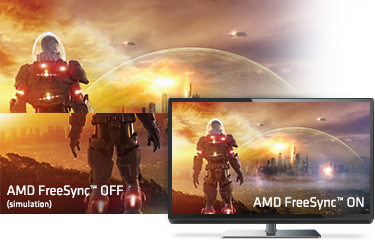
We don't want
to get in to any kind of NVIDIA vs. AMD debate here. What this really boils down
to is whether you're an NVIDIA or AMD graphics user. At the moment there isn't a
single standard which works from all graphics cards, so you need to pick a
monitor to match your graphics choice. AMD's option is cheaper and more
versatile for manufacturers to adopt but we don't feel that it will mean we will
have a much larger selection of FreeSync monitors to choose from. At the end of
the day the monitor manufacturers need to cater for their audience, and with
such a huge market share from NVIDIA they would be mad to ignore G-sync
offerings. Maybe at some point there will be a common approach between NVIDIA
and AMD but with both technologies being so new at the moment, we can't see that
happening for a while. G-sync may be more expensive, and limited when it comes to
connection options at the moment, but there is the added benefit of the native ULMB included
don't forget.
For more information from AMD
on FreeSync, see
their website.
FreeSync
Operation
AMD FreeSync
can support dynamic refresh rates between 9 and 240Hz but the actual supported
ranges depend on the display. In the case of the XG270HU the range supported is
40 to 144Hz. That means with FreeSync enabled the screens refresh rate can be
dynamically controlled between 40 and 144Hz. When you connect the display to a
compatible graphics card, with the relevant driver package installed the
display is detected as FreeSync compatible and gives the following pop up
message:

AMD kindly sent us a Club 3D Radeon R9 290 Series
for testing:
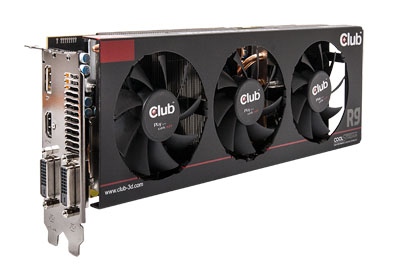
Within the Catalyst Control Centre there is an
added configuration option for FreeSync at the bottom as shown in the screenshot
below. You still have access to all the
normal OSD controls.
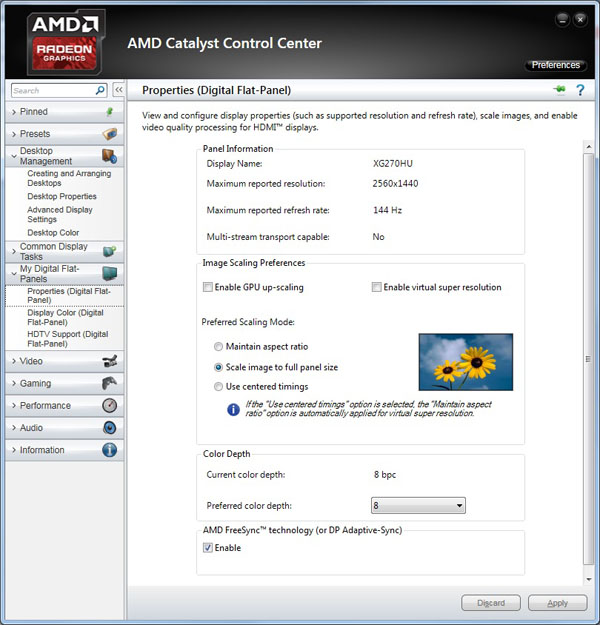
We don't want to go into too much depth about game
play, frame rates and the performance of FreeSync here as we will end up moving
away from characteristics of the monitor and into areas more associated with the
operation of the graphics card and its output. FreeSync is a combined graphics
card and monitor technology, but from a monitor point of view all it is doing is
supporting this feature to allow the graphics card to operate in a new way. We'd
encourage you to read some of the FreeSync reviews online as they go into a lot
more detail about graphics card rendering, frame rates etc as well.
Within the AMD press material and presentation
which we were invited to, they had carried out some tests of FreeSync and noted
a minor improvement in frame rates when FreeSync was enabled. We're talking
extremely minor here, up to about half a frame difference at best. Still, it's
better than any drop in performance! On the other hand they found a minor drop
in frame rate performance when testing NVIDIA G-sync, down by a couple of frames
at most. NVIDIA
had acknowledged this minor performance drop in the past although said they
were working on it. For those interested, there's some
more information here about the test environments used by AMD.
The results obtained by AMD were as follows:
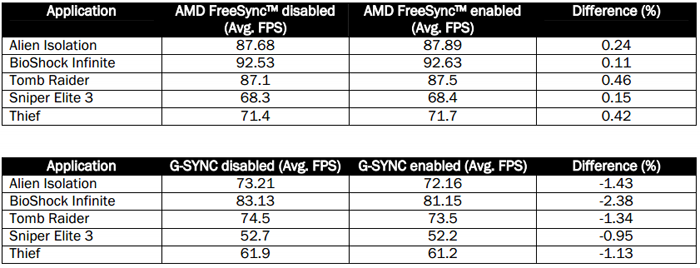
Above: AMD tests
of FreeSync and G-sync Frame rates
AMD concluded from their tests that enabling
FreeSync maintains a more consistent performance vs. the competition:
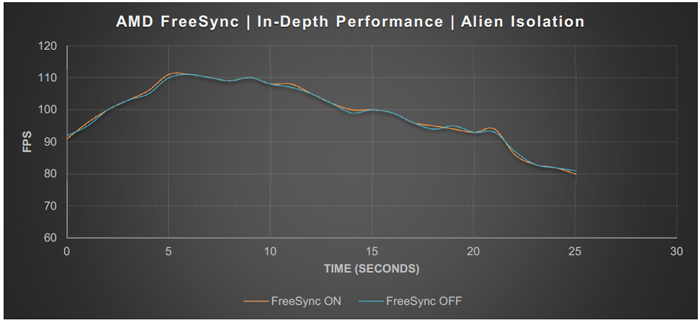
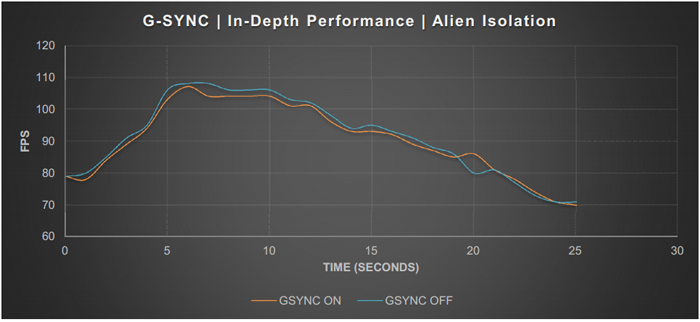
Really any difference here is extremely minor and
won't make any practical difference to the user.
Anandtech actually carried out some further tests themselves and found no
discernable difference between the two solutions. Perhaps there's some very
minor difference somewhere, but not something to worry about at all. We only
include it here as you're likely to hear about this in any AMD vs. NVIDIA
conversations.
In addition to these tests, AMD also checked how
each solution behaves if you operate outside of the supported range. i.e. what
happens if you provide a frame rate above the maximum supported 144Hz, or below
the bottom end of the range supported by the monitor. With NVIDIA G-sync, the
solution behaves as if you had V-sync on, capping the frame rate at 144fps
maximum for instance if you exceed 144Hz. With AMD FreeSync you actually have
the option as a user to either have V-sync on or off for operation above the
maximum supported refresh rate. So if you have a powerful enough system you are
able to output more frames if you want. Obviously you're back into the realms of
possible tearing etc with V-sync off, or into the realms of some possible lag
and stutter with V-sync on, but you have the choice as the user at least.
Their tests here confirm that operation, using
V-sync off when out of range of FreeSync. Again test environment
described here if you want more info.
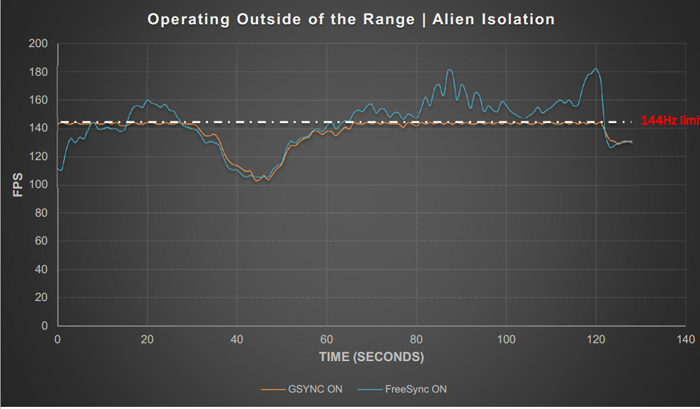
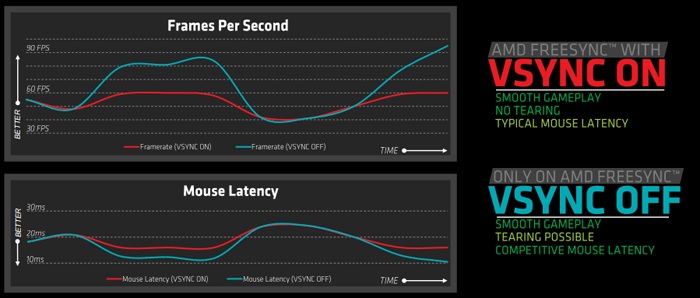
It should be noted that the real benefits of
variable refresh rate technologies really come into play when viewing lower frame rate content, around 40
- 75fps typically delivers the best results compared with Vsync on/off. At
consistently higher
frame rates as you get nearer to 144 fps the benefits of FreeSync (and G-sync) are not as
great, but still apparent. There will be a gradual transition period for each
user where the benefits of using FreeSync decrease, and it may instead be better
to use the Blur
Reduction feature if it is provided on the screen. Higher end gaming machines might be able to push out higher frame rates
more consistently and so you might find less benefit in using FreeSync. If
provided, a Blur
Reduction mode
could then help in another very important area, helping to reduce the perceived
motion blur caused by LCD displays. Keeping in mind that the XG270HU features a
large 2560 x 1440 resolution, you'd need a pretty powerful system to achieve
consistently high frame rates, so we'd encourage you to try FreeSync of course
to see how it affects your gaming usage. Sadly Acer haven't added a blur
reduction mode on this model anyway, so you might as well stick with FreeSync.
FreeSync Performance and the
XG270HU Display
|
From a monitor point of view the use of FreeSync creates a problem at the moment
on the XG270HU at the moment, just as it had on the BenQ XL2730Z we tested
recently. The issue is that the OD (overdrive) setting does nothing when you
connect the screen over DisplayPort to a FreeSync system. This applies whether
you are actually using FreeSync or not, you don't even need to have the option
ticked in the graphics card settings for the problem to occur. As a result, the
OD setting appears to be in the off state, and changing it to Normal or Extreme in
the menu makes no difference to real-World response times or performance. As a
result, response times are fairly slow at ~7.7ms G2G and there is a more noticeable blur to
the moving image. See
the more detailed response time tests in the previous
sections for more information, but needless to say this is not the optimum OD
(response time) setting on this screen. For some reason, the combination of
FreeSync support and this display disables the OD function.
This only happens when you are using a FreeSync
enabled graphics card, FreeSync capable drivers and the DisplayPort interface.
If you switch to DVI or any other interface (which don't support the FreeSync
feature) even from the same graphics card/driver then OD behaves as it should
again. If you use DisplayPort but revert to an older non-FreeSync enabled driver
package then OD works as it should. If you use a non-FreeSync supporting AMD
card, or a card from NVIDIA/Intel then OD functions as it should. It's only
when all 3 things are combined that the problem seems to occur. Obviously if you
eliminate one of them to make OD work properly, you lose the advantage of
FreeSync dynamic refresh rate control.
We know from our review of the BenQ XL2730Z, and
our conversations with them about it that the issue is a
known bug which apparently currently affects all FreeSync monitors. The
AMD FreeSync command disturbs the response time function, causing it to
switch off. It's something which will require an update from AMD to their driver
behaviour, which they are currently working on. It will also require a firmware
update for the screen itself to correct the problem. We know that AMD are
working on their updated drivers, and we've asked Acer for comment on how they
might handle firmware and screen updates.
Assuming that fixes the issue the performance when
using a FreeSync system should be better than now, as you can move from OD Off
to the better OD Normal setting. At the moment if you use the FreeSync function,
or even just have a FreeSync enabled system in place, the response times are
slower than they should be by a fair amount, and so you will experience a
moderate amount of blur. To be fair they aren't really slow (7.7ms G2G measured)
but they just aren't as fast as they could be and show some more noticeable
blurring than OD normal. If you need to, you can always switch to DVI or another
interface other than DisplayPort to benefit from the OD setting (but lose
FreeSync).
We will update this review section when we know
more about a fix for this issue.
Update 2nd July 2015 - Acer have
confirmed a firmware update has now been made available to their service teams
to address any issues people are facing with the activation of overdrive with
FreeSync systems. The following statement was provided to us: "Customer
service and experience are priorities for Acer. Customers owning an Acer XG270HU
Monitor may potentially experience slower response times when connected over
DisplayPort to FreeSync compatible graphic cards of the PC. When connecting to
PCs with other graphic cards or connection options there is no impact on the
performance and response time. Customers which believe they are experiencing a
potentially slower response time than normal, may contact the nearest Acer
Service Center for a firmware update."
|

Pursuit Camera Tests
We've already tested above the actual
pixel
response times and other aspects of the screen's gaming performance. We
wanted to carry out some pursuit camera tests as well to give an even more
complete idea of the performance of this screen, and the improvements made to
motion blur when using the Blur Reduction feature also.
Pursuit cameras are used to capture motion blur as
a user might experience it on a display. They are simply cameras which follow
the on-screen motion and are extremely accurate at measuring motion blur,
ghosting and overdrive artefacts of moving images. Since they simulate the eye
tracking motion of moving eyes, they can be useful in giving an idea of how a
moving image appears to the end user. It is the blurring caused by eye
tracking on continuously-displayed refreshes (sample-and-hold) that we are keen
to analyse with this new approach. This is not pixel persistence caused by
response times; but a different cause of display motion blur which cannot be
captured using static camera tests. Low response times do have a positive impact
on motion blur, and higher refresh rates also help reduce blurring to a degree.
It does not matter how low response times are, or how high refresh rates are,
you will still see motion blur from LCD displays under normal operation to some
extent and that is what this section is designed to measure. Further
technologies specifically designed to reduce perceived motion blur are required
to eliminate the blur seen on these type of sample-and-hold displays which we
will also look at.
We used the
Blurbusters.com Ghosting Motion Test which is designed to be used with
pursuit camera setups. The pursuit camera method is
explained at BlurBusters
as well as
covered in this research paper. We
carried out the tests at various refresh rates, with and without Blur Reduction enabled.
These UFO objects were moving horizontally at 960 pixels per second, at a frame
rate matching refresh rate of the monitor.

OD
Setting Normal
We conducted the above tests over the DVI
connection so that we could use the optimum OD setting of Normal. These tests
capture the kind of blurring you would see with the naked eye when tracking
moving objects across the screen. As you increase the refresh rate the perceived
blurring is reduced, as refresh rate has a direct impact on motion blur.
It is not
eliminated entirely due to the nature of the sample-and-hold LCD display and the
tracking of your eyes.
No matter how fast the refresh rate and pixel
response times are, you cannot eliminate the perceived motion blur without other
methods.
Unfortunately there is no Blur
Reduction mode available from this screen so you are not able to reduce
perceived motion blur further using a strobe backlight. See the relevant section
in our
BenQ XL2730Z review for an idea of how much blur can be eliminated using a
strobe backlight system.

Additional Gaming Features
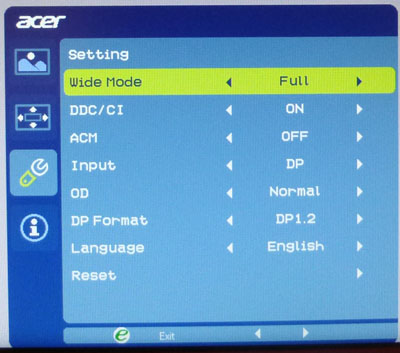
Aspect Ratio Control -
The XG270HU has 3 options for
aspect ratio control through the OSD 'setting' menu as shown above. There
are options for full, aspect and 1:1 pixel mapping. Nice to see an automatic
aspect ratio option available which will maintain the source input aspect ratio
and scale to fill as much of the screen as possible. Also great to see a 1:1
pixel mapping mode. These are certainly useful for connection of external games
consoles etc not running at 2560 x 1440 resolution. Note that NVIDIA G-sync
screens at this time are not provided with an internal scaler, and so having
these options available here is an advantage of using AMD FreeSync instead.
Preset Modes - There is a no specific
'game' mode available in the OSD eColor menu, so if you wanted something
different for your gaming uses you might want to try one of the other modes,
which have preset brightness levels.

Lag
We have written an in depth article about
input lag and the various measurement techniques which are used to evaluate
this aspect of a display. It's important to first of all understand the
different methods available and also what this lag means to you as an end-user.
Input Lag vs. Display Lag vs. Signal
Processing
To avoid confusion with different terminology we
will refer to this section of our reviews as just "lag" from now on, as there
are a few different aspects to consider, and different interpretations of the
term "input lag". We will consider the following points here as much as
possible. The overall "display lag" is the first, that being the delay between
the image being shown on the TFT display and that being shown on a CRT. This is
what many people will know as input lag and originally was the measure made to
explain why the image is a little behind when using a CRT. The older stopwatch
based methods were the common way to measure this in the past, but through
advanced studies have been shown to be quite inaccurate. As a result, more
advanced tools like SMTT provide a method to measure that delay between a TFT
and CRT while removing the inaccuracies of older stopwatch methods.
In reality that lag / delay is caused by a
combination of two things - the signal processing delay caused by the TFT
electronics / scaler, and the response time of the pixels themselves. Most
"input lag" measurements over the years have always been based on the overall
display lag (signal processing + response time) and indeed the SMTT tool is
based on this visual difference between a CRT and TFT and so measures the
overall display lag. In practice the signal processing is the element which
gives the feel of lag to the user, and the response time of course can
impact blurring, and overall image quality in moving scenes. As people become
more aware of lag as a possible issue, we are of course keen to try and
understand the split between the two as much as possible to give a complete
picture.
The signal processing element within that is quite
hard to identify without extremely high end equipment and very complicated
methods. In fact the studies by Thomas Thiemann which really kicked this whole
thing off were based on equipment worth >100,1000 Euro, requiring extremely high
bandwidths and very complicated methods to trigger the correct behaviour and
accurately measure the signal processing on its own. Other techniques which are
being used since are not conducted by Thomas (he is a freelance writer) or based
on this equipment or technique, and may also be subject to other errors or
inaccuracies based on our conversations with him since. It's very hard as a
result to produce a technique which will measure just the signal processing on
its own unfortunately. Many measurement techniques are also not explained and so
it is important to try and get a picture from various sources if possible to
make an informed judgement about a display overall.
For our tests we will continue to use the SMTT
tool to measure the overall "display lag". From there we can use our
oscilloscope system to measure the response time across a wide range of grey to
grey (G2G) transitions as recorded in our
response time
tests. Since SMTT will not include the full response time within its
measurements, after speaking with Thomas further about the situation we will
subtract half of the average G2G response time from the total display lag. This should allow us to give a good estimation of
how much of the overall lag is attributable to the signal processing element on
its own.
Lag Classification
To help in this section we will also introduce a broader classification system
for these results to help categorise each screen as one of the following levels:
-
Class 1)
Less than 16ms / 1 frame lag - should be fine for gamers, even at high levels
-
Class
2)
A lag of 16 -
32ms / One to two frames - moderate lag but should be fine for many gamers.
Caution advised for serious gaming and FPS
-
Class
3)
A lag of more
than 32ms / more than 2 frames - Some noticeable lag in daily usage, not
suitable for high end gaming
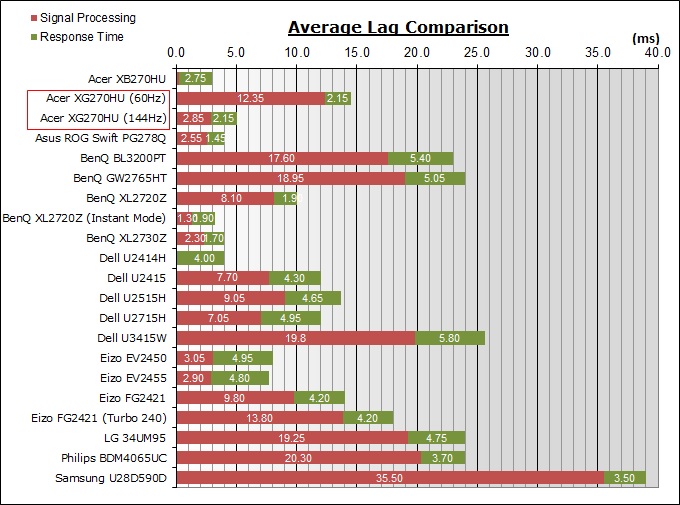
For the full reviews of the models compared here and the dates they were written
(and when screens were approximately released to the market), please see our
full
reviews index.
|
(Measurements in ms) |
60Hz |
144Hz |
|
Total Display Lag (SMTT
2) |
14.5 |
5.0 |
|
Pixel Response Time
Element |
2.15 |
2.15 |
|
Estimated Signal
Processing Lag |
12.35 |
2.85 |
|
Lag Classification |
1 |
1 |
|

Class
1 |
We have provided a comparison above against other
models we have tested to give an indication between screens. The screens
tested are split into two measurements which are
based on our overall display lag tests (using SMTT) and half the average G2G
response time, as measured by the oscilloscope. The response time is split from
the overall display lag and shown on the graph as the green bar. From there, the
signal processing (red bar) can be provided as a good estimation.
At 600Hz the screen showed a total average display lag of
14.5 ms as measured with SMTT 2. Taking into account half the average G2G
response time at 2.15ms ('Normal' OD setting), we can estimate that there is
~12.35 ms of signal
processing lag at this refresh rate. If you increase the refresh rate to 144Hz
the lag is reduced nicely though, with a total display lag recorded of 5.0ms,
giving an estimated 2.85ms of signal processing lag. This makes the screen very
suitable for gaming, even playing fast FPS games.

Gaming Summary
The overall gaming performance of the XG270HU was
mostly positive, if we ignore FreeSync for a moment. Pixel response times were
pretty much on par with the other fast TN Film panels we've tested, including
the very popular Asus ROG Swift PG278Q and recent BenQ XL2730Z. While the pixel
transitions were slightly slower, Acer had toned down the overshoot a bit which
we preferred. You will want to stick with the OD normal mode if possible for
optimum performance. Input lag was also low as well which was pleasing, although
you want to be running at a higher refresh rate is possible to offer the lowest
lag.
One significant upgrade compared with a lot of
older gaming screens was the additional
resolution, offering a big jump from 1080p to 1440p and keeping it up to date
with a few other modern gaming screens with high resolutions. Make sure
you have a powerful enough system to run this kind of resolution. For those who
can't output 2560 x 1440 @ 144Hz the addition of AMD's FreeSync technology
should be a welcome move. It does function correctly in terms of handling
dynamic refresh rates and offers a very useful alternative to traditional Vsync.
However, at the moment its implementation is not perfect, as it disables the OD
(overdrive) function and so leads to reduced response times. We saw the same
issue on the BenQ XL2730Z, and once Acer and AMD fix this issue we will update the
review accordingly as it should then mean FreeSync is a real benefit. Even with
the OD control not working with FreeSync systems, the response times aren't
exactly "slow", they just aren't optimum and up to what the screen is capable
of.
We were a little disappointed that there was no
blur reduction mode on this screen though. That comes as standard with G-sync
screens via their ULMB mode, and we saw it added as an extra to the BenQ XL2730Z
with FreeSync recently. Acer haven't added as blur reduction mode here
unfortunately so it can't quite keep up with some gaming screens in features.
It's lacking the massive range of gaming extras and useful tweaks that models
like the BenQ XL2730Z offer, but the actual panel performance underneath is
still strong.

Movies and Video

The following summarises the screens performance
in video applications:
-
27"
screen size makes it a reasonable option for an all-in-one multimedia screen,
but being quite a bit smaller than most modern LCD TV's of course.
-
16:9
aspect ratio is more well suited to videos than a 16:10 format screen, leaving
smaller borders on DVD's and wide screen content at the top and bottom.
-
2560 x
1440 resolution can support full 1080 HD resolution content.
-
Digital interfaces support HDCP for any encrypted and protected content
-
Good range of connectivity options provided
with DisplayPort, DVI and HDMI 2.0. Being FreeSync capable
does not limit the connections like a G-sync screen would, so it allows you to
still connect external devices if you want.
-
Cables provided in the box
for DisplayPort and DVI.
-
Moderate AG coating provides reasonably clear images with no major graininess,
and without the unwanted reflections of a glossy solution. Some graininess
apparent as with other TN Film panels, but shouldn't present a problem in
movies.
-
Wide
brightness range adjustment possible from the display, including a very high
maximum luminance of ~362
cd/m2 and a reasonable minimum
luminance of 85 cd/m2. This should afford you good control for different
lighting conditions. Contrast ratio remains stable across that adjustment
range as well and is good for a TN Film panel. Brightness regulation is
controlled without the need for PWM and so is flicker free for all brightness
settings.
-
Black
depth and contrast ratio are pretty good for a TN Film panel at 828:1 after
calibration. Detail in darker scenes should not be lost as a result.
-
There
is a specific 'movie' preset mode available but it's basically just a preset
brightness level.
-
Excellent pixel responsiveness which can handle fast moving scenes in movies
without issue. Quite low levels of overshoot as well. Stick with the 'Normal'
OD
setting.
-
While
the screen has a high refresh rate it is not NVIDIA 3D certified and so cannot
support 3D content.
-
Viewing angles are limited due to the use of TN Film panel technology. May
cause issues with gamma and contrast shift if you change your line of sight or
have several people trying to see the screen at once. Not really an ideal
technology for movies as a result of this viewing angle limitation.
-
No
noticeable backlight leakage which is good, even in darkened room conditions.
-
Very limited range of ergonomic adjustments
available from the stand, so not ideal if you want to keep moving the screen
or changing the viewing angle.
-
2x 2W
integrated speakers for some basic audio. Also an audio input and headphone
out connection on this monitor.
-
Decent
range of
hardware aspect ratio options which should provide you the scaling options you need.
-
Picture in picture (PiP) and Picture By Picture (PbP) are not available on
this model.

Conclusion
The XG270HU provided a good overall gaming screen,
with some strong panel performance but a lack of some of the bells and whistles
you will find from some other competing screens. Being a gaming screen there are
a few areas of importance to focus on. Response times are nice and low, and the
overshoot levels are actually pretty good and slightly better than most fast TN
Film gaming displays. There's support for high refresh rates which is a must for
a modern gaming screen, and the extra resolution provided is a big jump up from
the wide range of 1080p models available. Lag is also nice and low and the
overall gaming experience is positive. The addition of FreeSync should be a big
plus as well, although at the moment it isn't functioning as well as it could
because of the limits it places on the overdrive control. It's great that the
addition of FreeSync isn't bumping up the retail cost a lot, and also has
allowed Acer to provide a decent set of connectivity and scaling options from
the screen also.
Being a TN Film based panel you do have to of
course live with some of the limitations of this technology, most obviously the
restrictive viewing angles and colour/gamma shift. Default setup of the screen
was geared towards gaming, and it was a little tricky to correct the gamma curve
without a calibration tool which might put off some general users. The flicker
free backlight was very welcome, and there was a good range of brightness
adjustment offered from the backlight.
The screen felt a little lacking compared with
some high-end gaming screens. Models like the BenQ XL2730Z throw just about
every gaming extra at you that you might want or think of, so the XG270HU felt a
little more limited. Perhaps most noticeable was the lack of a blur reduction
mode which was a shame. The stand was also very limited and restrictive and we
would have perhaps liked a few more features and extras here. Still, the screen
retails for an attractive £430 GBP (inc VAT) which puts it about £70 cheaper
than the BenQ XL2730Z, and certainly a lot cheaper than G-sync models like the
Asus ROG Swift PG278Q (£630). If you're after a FreeSync gaming screen and don't
mind it being a little more limited, but at a lower cost, then this is worth
considering.
If you appreciate the review and enjoy reading and like our work, we would welcome a
donation
to the site to help us continue to make quality and detailed reviews for you.
|
Pros |
Cons |
|
Excellent response times, high
refresh rate support and low lag for gaming |
Restrictive viewing angles of
TN Film technology |
|
Flicker free backlight |
Missing a blur reduction mode
which competing screens offer |
|
FreeSync support will be very
useful once overdrive issue fixed. No cost overhead for providing FreeSync
either |
Limited stand and ergonomics |
|
Check Pricing and Buy - Direct Links
|
|
Amazon USA |
Amazon UK |
Amazon GER |
Amazon CAN
|
|
TFTCentral is a participant
in the Amazon Services LLC Associates Programme, an affiliate
advertising programme designed to provide a means for sites to earn
advertising fees by advertising and linking to Amazon.com, Amazon.co.uk,
Amazon.de, Amazon.ca and other Amazon stores worldwide. We also
participate in a similar scheme for Overclockers.co.uk. |
|